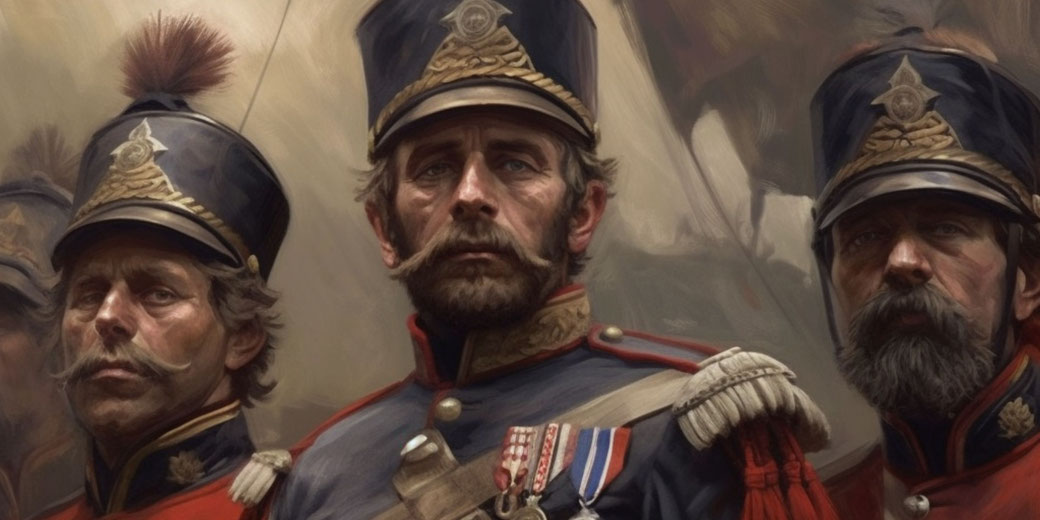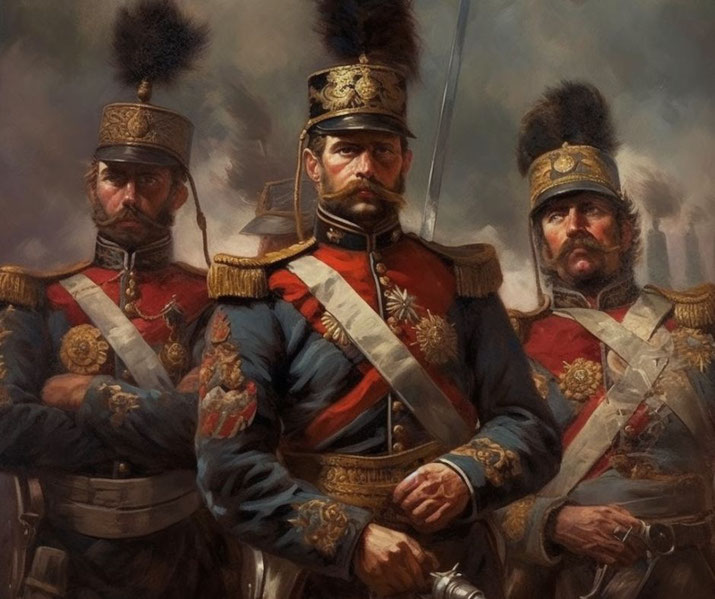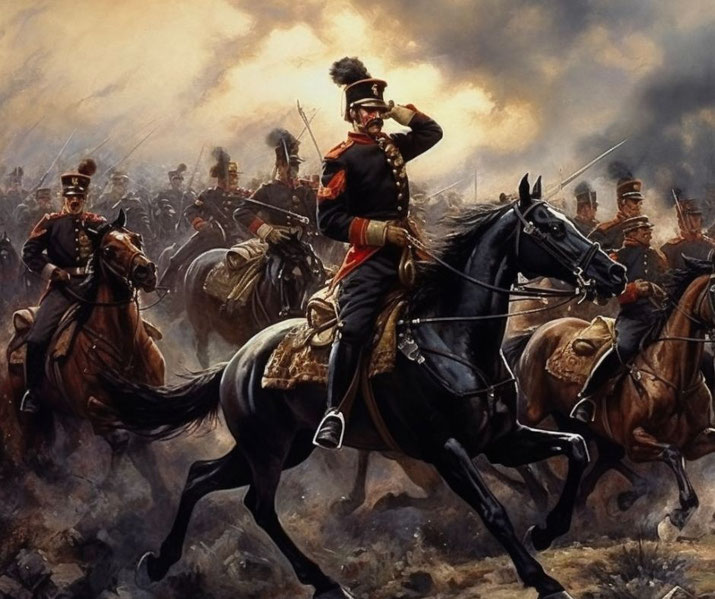The Crimean War: The first modern war?

The Crimean War, a significant yet often overlooked conflict of the 19th century, reshaped the political and military landscapes of Europe.
Spanning from October 1853 to February 1856, this grueling conflict pitted the combined forces of the Ottoman Empire, the United Kingdom, France, and Sardinia against the expansive Russian Empire.
The war was primarily fought on the Crimean Peninsula, though skirmishes stretched from the Baltic to the Pacific.
Famed for its disastrous charges, strategic blunders, logistical nightmares, and the profound human suffering it induced, the Crimean War nevertheless proved to be a watershed in military history.
It marked the beginning of modern warfare, featuring technological innovations like railways and the telegraph, as well as the early use of rifles and trench warfare.
Complex background to the conflict
At the heart of the conflict lay the "Eastern Question," a diplomatic dilemma precipitated by the decline of the once mighty Ottoman Empire.
As the Ottoman's grip on its diverse and vast territories weakened, European powers began to eye the region with strategic and territorial interest.
Of utmost concern was who would ultimately control the Bosporus and Dardanelles straits, the critical shipping routes that linked the Black Sea to the Mediterranean.
The key powers involved
The Crimean War involved several major players, each bringing their unique motivations and objectives to the conflict.
The Russian Empire, under Tsar Nicholas I, stood at one side of the conflict. Russia saw an opportunity to assert itself as the protector of Orthodox Christians within the Ottoman Empire, and to gain control over the vital warm-water ports of the Black Sea. The Tsar hoped that a successful campaign could lead to a major expansion of Russian influence in Eastern Europe and the Near East.
The Ottoman Empire, under Sultan Abdulmejid I, was at the forefront of resistance against Russian expansion. The Ottoman Empire, though in decline, remained a significant force and was keen to defend its sovereignty and maintain control over its territories, particularly the strategic Bosporus and Dardanelles straits. The Empire's ability to withstand Russian advances, however, was severely hampered by its internal issues, including ethnic tensions, administrative corruption, and military inefficiency.
On the Ottoman side, too, was the United Kingdom, led by Prime Minister George Hamilton-Gordon, 4th Earl of Aberdeen. Britain was concerned about maintaining the balance of power in Europe and safeguarding its imperial interests, particularly its routes to India. The British government feared that unchecked Russian influence over the Ottoman Empire could threaten these interests, which led them to enter the war.

France, under the leadership of Emperor Napoleon III, also joined the conflict on the side of the Ottoman Empire. For Napoleon III, the war presented an opportunity to assert French influence over the Catholic Church in Jerusalem, bolster his domestic popularity, and reestablish France's status as a leading European power after the turmoil of the 1848 revolutions.
Lastly, the Kingdom of Sardinia, under King Victor Emmanuel II and his prime minister, Count Camillo di Cavour, entered the war later in 1855. Eager to assert its presence in the European theatre and to remove Austrian influence over Italy, Sardinia saw participation in the war as a diplomatic move to gain support for Italian unification.
How did the war start?
The Crimean War, while rooted in geopolitical ambitions and religious disputes, was triggered by a series of seemingly minor altercations.
The tension began to rise when, in 1852, France and Russia clashed over the rights of Christian minorities in the Holy Land, which was under Ottoman control.
The dispute over who should be the protector of Christians in Palestine - Orthodox Russia or Catholic France - was emblematic of the broader struggle for influence over the declining Ottoman Empire.
Despite Ottoman attempts to maintain neutrality and balance the privileges of both Christian groups, the situation continued to escalate.
In 1853, Tsar Nicholas I used the unresolved religious dispute as a pretext to push his expansionist agenda, sending his troops into the Ottoman-controlled Danubian Principalities (modern-day Romania) under the guise of protecting Orthodox Christians.
This incursion represented a significant threat to the Ottomans and was widely seen as a move to seize control of the straits connecting the Black Sea to the Mediterranean.
In response, the Ottoman Empire issued an ultimatum demanding Russian withdrawal.
When Russia ignored this demand, the Ottomans declared war in October 1853.
Early battles largely took place in the Danubian Principalities and the Black Sea, where a Russian naval attack on an Ottoman squadron at Sinop alarmed Britain and France and brought them into the war on the Ottoman side.
Britain and France, both wary of growing Russian influence and desiring to maintain the balance of power in Europe, officially declared war on Russia in March 1854.
The theater of war soon moved to the Crimean Peninsula, with the Allied intention to capture the significant Russian naval base at Sevastopol.
Sardinia joined the Allied powers in 1855, seeing an opportunity to gain political favor for the cause of Italian unification.
The major events of the Crimean War
The Crimean War was marked by several significant battles, each underscoring the operational challenges and military innovations of the time.
The Battle of Alma (September 1854) was the first major encounter between the Russian and the Allied forces, resulting in a decisive Franco-British victory. The battle took place on the banks of the Alma River and saw the allies successfully push back the Russian forces, opening the path towards Sevastopol. However, the Allies failed to capitalize on their victory by swiftly pursuing the retreating Russian army, leading to a protracted siege of Sevastopol that lasted over a year.
The Battle of Balaclava (October 1854) is remembered mainly for the infamous Charge of the Light Brigade, where a miscommunicated order led to a disastrous cavalry charge by the British light brigade straight into the teeth of the Russian artillery. Despite the heavy losses, the battle did not significantly change the strategic position of the armies, but it exposed serious command and communication issues within the Allied forces.
The Battle of Inkerman (November 1854) was one of the most fiercely fought engagements of the Crimean War. The Russians attempted to lift the Siege of Sevastopol by attacking the Allies on multiple fronts but suffered heavy losses. The battle, often referred to as the "Soldiers' Battle," was characterized by chaotic, close-quarters combat in heavy fog, with limited involvement from the high command on both sides.

The Siege of Sevastopol (October 1854 – September 1855) was the defining event of the Crimean War. The Allies had initially expected a quick victory; however, the siege dragged on for almost a year due to the city's strong fortifications and the defenders' stubborn resistance. The siege saw massive casualties on both sides, the development of trench warfare, and significant advances in the use of artillery. The fall of Sevastopol marked the beginning of the end for Russia in the war, leading to renewed peace negotiations.
How warfare changed during the conflict
The Crimean War represented a significant shift in military strategy, tactics, and technology, laying the groundwork for modern warfare.
In terms of strategy, the war highlighted the importance of logistical planning, as the lack thereof resulted in significant hardships for both sides.
The Siege of Sevastopol was a prime example of a new form of warfare - trench warfare - that would become a defining characteristic of battles in the 20th century.
This siege warfare highlighted the need for sustained supply chains, well-prepared fortifications, and the ability to endure protracted engagements.
Tactical elements of the Crimean War also shifted as a result of new technologies and battlefield realities.
One significant innovation was the widespread use of the Minié rifle, a muzzle-loaded rifle that had a greater range and accuracy than previous infantry weapons.
This increased range shifted the advantage to the defensive side in battles, as defenders could fire effectively on attackers while remaining behind their fortifications.
However, old tactics like the frontal cavalry charge, as seen in the ill-fated Charge of the Light Brigade at Balaclava, were shown to be increasingly obsolete in the face of modern artillery and rifle fire.
On the technological front, the Crimean War saw several noteworthy developments.
Railways were used extensively for troop and supply transport, making it one of the first wars to take advantage of this new technology.
Telegraph lines were laid across the Black Sea, allowing for faster communication between the war front and the home front.
The war also saw significant advances in medical practices, largely due to the pioneering work of Florence Nightingale and Mary Seacole, who established modern nursing practices in the harsh conditions of the war.
In naval technology, the Crimean War featured one of the first clashes of ironclad warships when the Russian navy scuttled their ships to block the entrance to Sevastopol harbor.
What ended the Crimean War?
The end of the Crimean War came about due to a combination of military outcomes, diplomatic efforts, and changes within the belligerent nations themselves.
On the battlefield, the decisive moment was the fall of Sevastopol in September 1855.
The Allies had maintained a long, punishing siege of the strategic city, and its capture marked a turning point in the war.
The heavy losses, coupled with failures on other fronts, started to shift the balance against Russia.
In the diplomatic realm, the powers involved in the war had been attempting to negotiate a resolution.
The fall of Sevastopol added urgency to these efforts. The ensuing negotiations eventually resulted in the Treaty of Paris, signed in March 1856.
This treaty brought an official end to the war, but it also established a new balance of power in Europe.
Under the terms of the Treaty of Paris, Russia conceded to several demands: it agreed to respect the sovereignty and territorial integrity of the Ottoman Empire, and to renounce its claim to a protectorate over the latter's Christian subjects.
Importantly, the Black Sea was neutralized, with both the Ottomans and the Russians agreeing to maintain no naval presence there - a significant blow to Russia’s strategic ambitions.
Furthermore, the Dardanelles Strait was closed to all warships, barring Russia's direct access to the Mediterranean.
In Russia, the war's end came in the wake of Tsar Nicholas I's death and the ascension of Alexander II.
The new Tsar, recognizing the state's dire circumstances, sought peace and was more willing to make concessions.
The war's end did not mean the end of the Eastern Question - far from it. The Crimean War was merely a pause in the ongoing geopolitical struggle.
However, the war and its conclusion led to significant changes in the political and social landscapes of Europe, setting the stage for the tumultuous events of the late 19th and early 20th centuries.
The important role of media and journalism during the war
The Crimean War is often regarded as the first "modern" war due to its significant coverage by the media, particularly through war correspondence.
For the first time in history, the public could follow the events of the war in almost real-time, leading to a substantial impact on public opinion and shaping the perception and narrative of the war.
The most notable of these war correspondents was William Howard Russell of The Times.
His vivid reports from the battlefield highlighted the realities of war, including the harsh conditions faced by the soldiers, the incompetence of certain commanders, and the general mismanagement of the war effort.
Russell's reports had a substantial impact back home, leading to public outcry, shifts in public opinion, and eventually, changes in the administration of the British army.
The Crimean War was also the first to be documented through photography. Pioneering photographers like Roger Fenton braved the conditions of the war to capture images that provided a stark and powerful illustration of war's grim realities.
His photographs, though devoid of actual combat due to the limitations of photography at the time, captured the toll of war, the barren landscapes, and the posed portraits of soldiers, making the war a tangible reality for those back home.
Simultaneously, the use of the telegraph allowed for quicker relay of information from the frontlines to the public back home.
News that would have taken weeks to reach home could now be disseminated in days or even hours.
This not only allowed for more timely reporting but also meant that governments and military commanders could react to events more quickly.
However, this increased media scrutiny was a double-edged sword. On the one hand, it increased public awareness and engagement with the war.
On the other, it often led to hasty judgments and pressured governments and military commanders to make rapid responses, often without fully understanding the situation on the ground.
The global impacts of the Crimean War
One of the war's most immediate impacts was the shift in the balance of power in Europe.
Russia was temporarily weakened, its ambitions of southward expansion thwarted, and its influence over the Ottoman Empire diminished.
France re-emerged as a dominant European power, while Britain's role as a global power was affirmed.
The involvement of the Kingdom of Sardinia, though relatively minor, played a significant part in gaining diplomatic support for Italian unification, a process which would significantly alter the European political landscape.
The war also led to significant reforms in the military. In Britain, the inadequacies exposed by the war, particularly in logistics, strategy, and medical care, led to extensive military and administrative reforms, including the establishment of a professional General Staff and improvements in military healthcare.
In Russia, the war's outcome demonstrated the obsolescence of its serf army and led to significant military modernization under Tsar Alexander II, who also embarked on a series of domestic reforms, including the emancipation of the serfs in 1861.
The Crimean War marked a turning point in war journalism and public perception of war.
The extensive coverage by correspondents such as William Howard Russell and the photography of Roger Fenton brought the realities of war to the public consciousness, leading to changes in how wars were reported and perceived by the public.
The war also had a profound impact on medical practices. The dreadful conditions and high mortality rates in field hospitals led to significant advances in medical care, notably due to the work of Florence Nightingale.
Her pioneering work in nursing and sanitation laid the foundations of modern nursing and revolutionized the treatment of wounded soldiers.
In the Ottoman Empire, despite being on the winning side, the war highlighted the Empire's weaknesses, exacerbating its "sick man of Europe" image.
The need for modernization became evident, leading to the Tanzimat reforms, which aimed to modernize the Ottoman Empire along European lines.
What do you need help with?
Download ready-to-use digital learning resources
Copyright © History Skills 2014-2025.
Contact via email
With the exception of links to external sites, some historical sources and extracts from specific publications, all content on this website is copyrighted by History Skills. This content may not be copied, republished or redistributed without written permission from the website creator. Please use the Contact page to obtain relevant permission.





